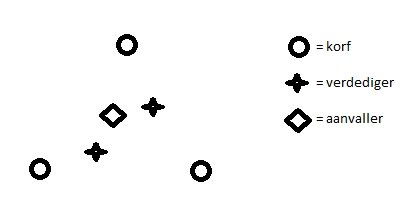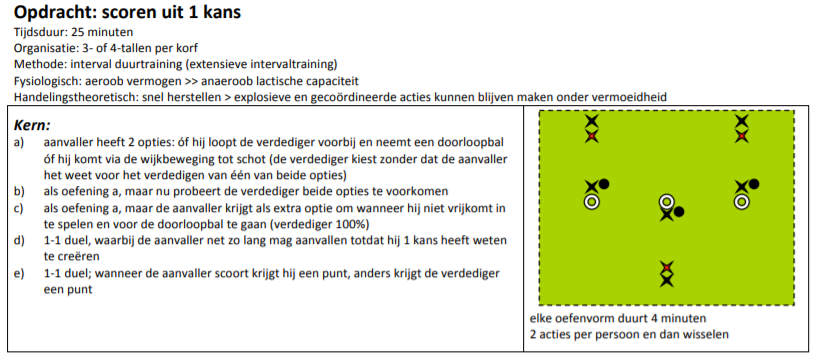Korfball drills for technique attack / score
Party form.
- Two baskets facing each other and two teams.
- Practicing how to do it in the matches.
- as a defender:
- rear (under the basket)
- front (under basket)
- I see you (under basket) other lady on it
- gone (if you called first, in front of/behind)
- beside you
The exercise starts in the 4-0 formation.
- The ball is passed from player 1 to player 2, after which player 1 fills the rebound-position.
- Player 3 fills the gap left by player 1 by connecting to the front.
- This creates space for player 4 to connect behind the basket.
- With this the 3-1 is realised, players 2,3 and 4 form a triangle around the basket.
The next step is to make a pass, so towards the 2-2.
- Player 2 passes the ball to player 3, and player 4 passes to him.
- Timing is very important here.
- Player 4, the attacker, must pass to the attacker just in time.
- If he is too early, his defender can pass to him, if he is too late the defender of player 3 can recover his defensive position.
- The perfect timing is therefore that player 3 can pass the ball as soon as he receives it, and that player 4 is not waiting for the ball.
- As soon as player 4 with the ball is in the passing position, both shooters, players 2 and 3, have to make an action to get a shot.
- This can be a dodging move or a wide move.
- The initiator, player 4, chooses a shooter (in the video player 2) and passes the ball to the shooter.
- The shooter takes a shot, and the rebounder, player 1, catches the ball.
- The player who did not make the shot (in the video, player 3) keeps moving and gets the ball as soon as he is caught by player 1, and still makes the shot.
- This can be called the bonus shot. Why is this shot important?
- It forces both players to keep moving, and they get a reward in the form of a shot. Player 1 catches the ball again, and the exercise is over.
Everyone turns one spot and the exercise can start again.
- You start with 3 players at a pole.
- Number 1 runs aside, gets the ball and shoots, then the one under the post (player 3) catches the ball.
- At that moment player 2 has to cut in front of player 1 and run for the second chance.
- Continue this way until one of the two has made three.
- The loser changes places with the one under the basket, a winner may stay at the basket a maximum of 3 times.
- There are 3 posts placed in a triangle, pointing to the centre of the triangle.
- The defenders try to prevent the attacker from scoring.
- Do this until the attacker has scored twice or 1 minute has passed and then turn around.

- You have the team form a circle around the trainer.
- They have to keep moving; when they are called left, they turn left and sprint away.
- When the call is to the right, they turn right and sprint away
- You have an attacker at 5 meters in front of the basket who is going to shoot on the move.
- Underneath the basket there is a declarator and a rebounder.
- After having played the ball, the attacker leaves the room.
- The attacker shoots as soon as he has the ball and runs immediately to catch it himself.
- The attacker only has a point when he catches the ball himself.
- The rebounder has a point when he catches the ball.
In teams of four, two attackers and two defenders.
- Player 1 with the ball throws it to player 2.
- Player 1 comes next to player 2
- Player 2 throws the ball back and runs deep
- Player 1 throws the ball to player 2
- Player 1 goes right in for catch and player 2 shoots.
In short: exercise with the emphasis on turning away from the opponent.
Organisation: Each team of five or four players has a ball and an area of about 20 by 20 metres. The players are numbered.
a ) Number 1 is attacking, number 2 is defending and numbers 3, 4 and 5 are playing together with the attacking player. Everybody can move freely through the area. The attacker always gets the ball back from numbers 3, 4 and 5. The defender's task is to intercept the ball. Can the attacker manage not to lose the ball a single time? The ball may not fall on the ground either! After about 30 seconds the players change tasks: number 3 attacks, number 4 defends, etc. until everyone has been attacker and defender once.
If necessary, extend the task next time:
b ) As a., but give the instruction that the attacker always has to turn away from her defender: that way she can both pass and receive the ball back easily. I call this: 'cutting and turning', others call it 'keeping your opponent on your back'.
c ) As a., but now the team-mates 3, 4 and 5 stand still in a triangle with a distance of about 15 metres. This makes it more difficult for the attacker.
d ) It becomes even more difficult if the attacker is instructed to pass the ball to the other players in a fixed order. She now has to run in circles, so that the defender knows exactly where the ball will go, or where the attacker wants to run to. Many balls will now be intercepted, or at least touched.
e ) Again part c. Show that the attacker has an easier time of it now because of the freedom of choice By turning away from her opponent, she creates a sea of space for herself!
- You have two mats in the room, two teams have to defend each a mat of their own.
- But before they can attack, one of the two teams must complete a task. The team that finishes first gets the ball and may attack.
- The other teams may only move once their team member has also completed the task.
- You are not allowed to run with the ball, so you have to pass.
- you have three kids per post.
- 1 is the attacker,
- 1 is the defender and
- 1 is the attacker, 1 is the defender and 1 is the attacker/catcher.
- the attacker must try to score and the defender must prevent this.
- Change when the attacker has scored








